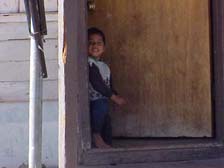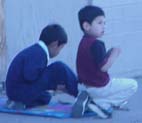| Home page
biography
Who is observing who?
Ignorance
Subdivisions...a good
thing?
Where would you send
your kids?
letter
†
|
WHERE WOULD YOU SEND YOUR KIDS?
††††††††††† What would you do, if
your children had to go to a school that did not have a good academic
record?† Well,
 unfortunately, many people have to deal with this situation.†
Not everyone can afford to live in a neighborhood where the school
district is known for ITS academic achievement.† This should not have
to be the situation, yet unfortunately, it is.† In this paper I will
compare two school districts, one of which is located in North Phoenix
(Oakwood Elementary School) and the other located in South Phoenix
(Cesar Chavez Middle School).† I chose these schools, because Oakwood
is a popular school in North Phoenix and Cesar Chavez is a popular
school in South Phoenix.† I got my information from http://azcentral.greatschools.net/cgi-bin/az/achievement.†
I will be concentrating on grades six to eight.† The academic achievement
differences are almost unbelievable, and will most likely shock you.
unfortunately, many people have to deal with this situation.†
Not everyone can afford to live in a neighborhood where the school
district is known for ITS academic achievement.† This should not have
to be the situation, yet unfortunately, it is.† In this paper I will
compare two school districts, one of which is located in North Phoenix
(Oakwood Elementary School) and the other located in South Phoenix
(Cesar Chavez Middle School).† I chose these schools, because Oakwood
is a popular school in North Phoenix and Cesar Chavez is a popular
school in South Phoenix.† I got my information from http://azcentral.greatschools.net/cgi-bin/az/achievement.†
I will be concentrating on grades six to eight.† The academic achievement
differences are almost unbelievable, and will most likely shock you.
††††††††††† All school districts in
Arizona now require that students take the Stanford 9 test.† The Stanford
9 test assesses how well students are learning basic skills and how their performance
compares to students in other states.† The subjects are math, reading,
and writing.† These subjects are considered the three fundamental
subjects.† Every school districtís goal is to score 100% on all the
tests, but as you will see the difference in actual achievements are
striking.† Cesar Chavez scored an average of 18%.† Oakwood scored
an average of 80%.† This is an extreme difference, this difference
is over 62% .
how well students are learning basic skills and how their performance
compares to students in other states.† The subjects are math, reading,
and writing.† These subjects are considered the three fundamental
subjects.† Every school districtís goal is to score 100% on all the
tests, but as you will see the difference in actual achievements are
striking.† Cesar Chavez scored an average of 18%.† Oakwood scored
an average of 80%.† This is an extreme difference, this difference
is over 62% .
††††††††††† To what can be attributed
to this wide discrepancy in achievement?† Some say it is the classroom
size, school supplies, or students desire to learn.† Although these
factors are important, letís stop ignoring the other aspects that
I believe affects education and test scores more.† Income and minorities
are two big things that come to mind, when South Phoenix is mentioned.†
South Phoenix is about 67% minority population.† As opposed to North
Phoenix, where the majority is "White".† Also, in South Phoenix, there
is a high poverty rate, unlike North Phoenix, where there more people
living there who have money.† As you can see, by having a lower income
in the neighborhood, means that there is less income for education.†
Yet, having a high income in the
 Teachers are able to make more money if they teach on the North side
of Phoenix.† Also, people in North Phoenix look for the best teachers
and are able to be choosy about who they want to teach in their school.†
In South Phoenix, being choosy about who teaches in your school is
almost unheard of.† This is due to the fact that North Phoenix is
considered a more attractive place to work.† The neighborhoods are
safer and the people that live there all have more money.† Also, many
people are scared about the high crime rate in South Phoenix, which
makes teaching in South Phoenix less attractive.† Even more, imagine
getting a job, where almost everyone who is in your classroom is a
first generation American citizen trying to learn English. †This makes
working in South Phoenix not only a lesser paying job, but also a
more stressful job.
Teachers are able to make more money if they teach on the North side
of Phoenix.† Also, people in North Phoenix look for the best teachers
and are able to be choosy about who they want to teach in their school.†
In South Phoenix, being choosy about who teaches in your school is
almost unheard of.† This is due to the fact that North Phoenix is
considered a more attractive place to work.† The neighborhoods are
safer and the people that live there all have more money.† Also, many
people are scared about the high crime rate in South Phoenix, which
makes teaching in South Phoenix less attractive.† Even more, imagine
getting a job, where almost everyone who is in your classroom is a
first generation American citizen trying to learn English. †This makes
working in South Phoenix not only a lesser paying job, but also a
more stressful job.
What can be done to stop this unfairness?†
Unfortunately, the answer is not a simple one.† It may take years
of change in order to get the area in South Phoenix equal to that of
North Phoenix.† Yet, this cannot be changed by one person alone; it will
take a community of people to make sure that children, no matter where
they live get the same educational benefits.† I hope, that after you
have seen this data, it will open your eyes to what needs to be done.†
I know that if enough people get together, then it will be possible
to make sure our future and the future of those to be, will be a bright
one.
*Data from Oakwood:
| Grade 6 |
National Percentile Rank |
Language Arts |
Math |
Reading |
| 50TH PERCENTILE
IS THE NATIONAL AVERAGE |

|


|
70

|
66

|
68

|
73

|


|


|
81

|
82

|
85

|
85

|


|


|
77

|
73

|
74

|
78

|


|

|

|
† |
†2000† |
†2001† |
†2002† |
†2003† |
† |
† |
†2000† |
†2001† |
†2002† |
†2003† |
† |
† |
†2000† |
†2001† |
†2002† |
†2003† |
† |
| Grade 7 |
National Percentile Rank |
Language Arts |
Math |
Reading |
| 50TH PERCENTILE
IS THE NATIONAL AVERAGE |

|


|
83

|
84

|
80

|
87

|


|


|
80

|
81

|
78

|
86

|


|


|
78

|
78

|
76

|
79

|


|

|

|
† |
†2000† |
†2001† |
†2002† |
†2003† |
† |
† |
†2000† |
†2001† |
†2002† |
†2003† |
† |
† |
†2000† |
†2001† |
†2002† |
†2003† |
† |
| Grade 8 |
National Percentile Rank |
Language Arts |
Math |
Reading |
| 50TH PERCENTILE
IS THE NATIONAL AVERAGE |

|


|
79

|
77

|
77

|
78

|


|


|
76

|
82

|
82

|
80

|


|


|
75

|
76

|
78

|
77

|


|

|

|
† |
†2000† |
†2001† |
†2002† |
†2003† |
† |
† |
†2000† |
†2001† |
†2002† |
†2003† |
† |
† |
†2000† |
†2001† |
†2002† |
†2003† |
† |
*Data from Cesar Chavez
| Grade 6 |
National Percentile Rank |
Language Arts |
Math |
Reading |
| 50TH PERCENTILE
IS THE NATIONAL AVERAGE |

|


|
17

|
13

|
17

|
9

|


|


|
22

|
17

|
28

|
18

|


|


|
24

|
17

|
27

|
20

|


|

|

|
† |
†2000† |
†2001† |
†2002† |
†2003† |
† |
† |
†2000† |
†2001† |
†2002† |
†2003† |
† |
† |
†2000† |
†2001† |
†2002† |
†2003† |
† |
| Grade 7 |
National Percentile Rank |
Language Arts |
Math |
Reading |
| 50TH PERCENTILE
IS THE NATIONAL AVERAGE |

|


|
22

|
15

|
22

|
28

|


|


|
20

|
15

|
19

|
23

|


|


|
19

|
15

|
17

|
27

|


|

|

|
† |
†2000† |
†2001† |
†2002† |
†2003† |
† |
† |
†2000† |
†2001† |
†2002† |
†2003† |
† |
† |
†2000† |
†2001† |
†2002† |
†2003† |
† |
| Grade 8 |
National Percentile Rank |
Language Arts |
Math |
Reading |
| 50TH PERCENTILE
IS THE NATIONAL AVERAGE |

|


|
27

|
15

|
25

|
17

|


|


|
21

|
18

|
21

|
23

|


|


|
20

|
19

|
25

|
26

|


|

|

|
† |
†2000† |
†2001† |
†2002† |
†2003† |
† |
† |
†2000† |
†2001† |
†2002† |
†2003† |
† |
† |
†2000† |
†2001† |
†2002† |
†2003† |
† |

†
|


 how well students are learning basic skills and how their performance
compares to students in other states.† The subjects are math, reading,
and writing.† These subjects are considered the three fundamental
subjects.† Every school districtís goal is to score 100% on all the
tests, but as you will see the difference in actual achievements are
striking.† Cesar Chavez scored an average of 18%.† Oakwood scored
an average of 80%.† This is an extreme difference, this difference
is over 62% .
how well students are learning basic skills and how their performance
compares to students in other states.† The subjects are math, reading,
and writing.† These subjects are considered the three fundamental
subjects.† Every school districtís goal is to score 100% on all the
tests, but as you will see the difference in actual achievements are
striking.† Cesar Chavez scored an average of 18%.† Oakwood scored
an average of 80%.† This is an extreme difference, this difference
is over 62% . Teachers are able to make more money if they teach on the North side
of Phoenix.† Also, people in North Phoenix look for the best teachers
and are able to be choosy about who they want to teach in their school.†
In South Phoenix, being choosy about who teaches in your school is
almost unheard of.† This is due to the fact that North Phoenix is
considered a more attractive place to work.† The neighborhoods are
safer and the people that live there all have more money.† Also, many
people are scared about the high crime rate in South Phoenix, which
makes teaching in South Phoenix less attractive.† Even more, imagine
getting a job, where almost everyone who is in your classroom is a
first generation American citizen trying to learn English. †This makes
working in South Phoenix not only a lesser paying job, but also a
more stressful job.
Teachers are able to make more money if they teach on the North side
of Phoenix.† Also, people in North Phoenix look for the best teachers
and are able to be choosy about who they want to teach in their school.†
In South Phoenix, being choosy about who teaches in your school is
almost unheard of.† This is due to the fact that North Phoenix is
considered a more attractive place to work.† The neighborhoods are
safer and the people that live there all have more money.† Also, many
people are scared about the high crime rate in South Phoenix, which
makes teaching in South Phoenix less attractive.† Even more, imagine
getting a job, where almost everyone who is in your classroom is a
first generation American citizen trying to learn English. †This makes
working in South Phoenix not only a lesser paying job, but also a
more stressful job.
